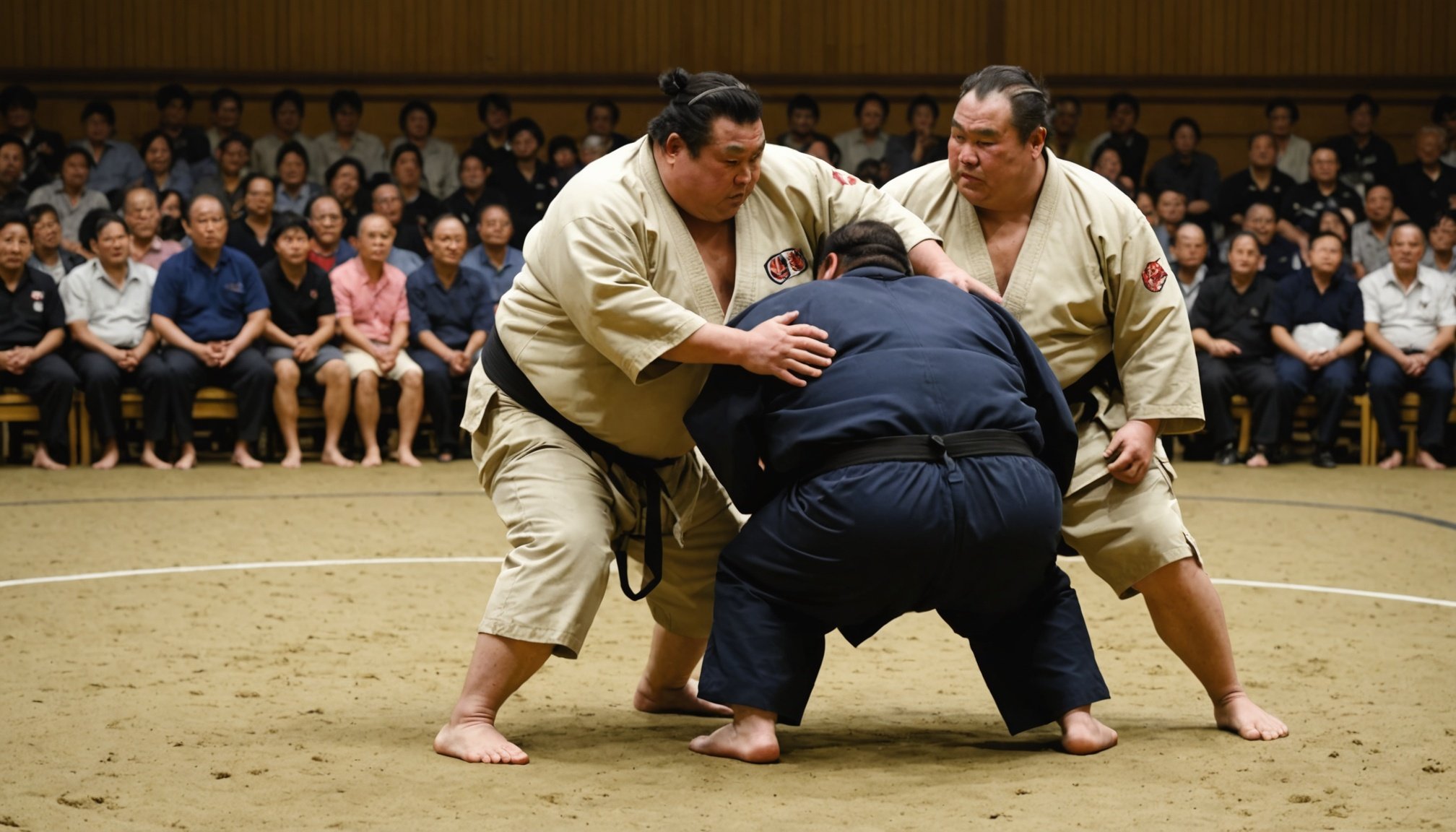Mastering the Tachiai: Strategies for UK Sumo Wrestlers to Elevate Their Initial Charge Technique
Understanding the Tachiai: The Heart of Sumo Wrestling
The tachiai, or the initial charge, is the pivotal moment in a sumo match where the two wrestlers engage for the first time. It sets the tone for the entire bout and can often determine the outcome. For UK sumo wrestlers looking to improve their skills, mastering the tachiai is crucial.
In sumo, the tachiai is more than just a physical collision; it is a mental and strategic engagement. As Kotoshōgiku Kazuhiro, a renowned Japanese sumo wrestler, once said, “The tachiai is where you show your strength and your will to win. It’s not just about power, but also about timing and technique.”[1]
Also to see : Discover the Top Stretching Routines to Boost Flexibility for Judo Athletes in the UK
Preparing for the Tachiai
To excel in the tachiai, sumo wrestlers must prepare both physically and mentally. Here are some key strategies:
Physical Preparation
- Strength and Conditioning: Sumo wrestlers need to build significant strength, particularly in their legs, core, and upper body. This involves a rigorous training regimen that includes weightlifting, cardio exercises, and specific sumo drills.
- Flexibility and Mobility: Good flexibility and mobility are essential for maintaining balance and generating power during the tachiai. Incorporating stretching exercises and martial arts like aikido or judo can help improve flexibility.
- Diet and Nutrition: A balanced diet rich in protein, carbohydrates, and healthy fats is vital for maintaining the necessary weight and energy levels. Sumo wrestlers often follow a traditional Japanese diet that includes foods like chankonabe, a hearty stew.
Mental Preparation
- Focus and Concentration: Mental toughness is as important as physical strength in sumo. Wrestlers need to focus on their opponents and anticipate their moves. Techniques like meditation and visualization can help improve concentration.
- Strategy and Adaptability: Each opponent presents a unique challenge. Sumo wrestlers must study their opponents’ techniques and adapt their strategy accordingly. For example, if an opponent is known for a strong yori-kiri (force out), the wrestler might focus on defending against this technique.
Techniques for a Successful Tachiai
Here are some specific techniques that can enhance a sumo wrestler’s tachiai:
In the same genre : Discover the Decade”s Top Ten UK Combat Sports Icons Who Shaped the Landscape
Grip and Stance
- Yotsu-sumo: This style, favored by Kotoshōgiku Kazuhiro, involves grabbing the opponent’s mawashi (belt) with a right hand outside and left hand inside grip (hidari-yotsu). This grip allows for strong control and leverage[1].
- Stance: A stable stance is crucial for generating power. Sumo wrestlers should keep their feet shoulder-width apart, with their weight evenly distributed between both legs.
Initial Charge Strategies
- Timing: The timing of the tachiai is critical. Wrestlers need to synchronize their charge with the gyoji’s (referee’s) signal to avoid being penalized for a false start[2].
- Power Generation: The initial charge should be powerful but controlled. Wrestlers should use their legs and core to generate force, rather than just their upper body.
Case Study: Kotoshōgiku Kazuhiro’s Approach
Kotoshōgiku Kazuhiro, known for his aggressive and direct fighting style, provides a valuable case study. Here are some key aspects of his approach:
Fighting Style
- Yotsu-sumo Specialist: Kotoshōgiku was a specialist in yotsu-sumo, techniques that involve grabbing the opponent’s mawashi. His most common winning technique was the straightforward yori-kiri (force out), used in sixty percent of his career victories[1].
- Gaburi-yori: His trademark technique was gaburi-yori, which involves using the torso to bump the opponent out, aided by a low center of gravity and momentum.
Mental Approach
- Calming Influence: Despite his aggressive style, Kotoshōgiku emphasized the importance of staying calm. He once said, “I’m getting calmer every passing day. I’ve come through tough times so I’d like to have the mindset to enjoy this.”[1]
- Self-Motivation: Kotoshōgiku’s success was also attributed to his self-motivation. He reflected on the ten-year wait for a Japanese winner and noted that Japanese wrestlers may lack the will to win that Mongolian wrestlers have shown.
Training Tips for UK Sumo Wrestlers
For UK sumo wrestlers looking to improve their tachiai, here are some practical training tips:
Drills and Exercises
- Butsukari-keiko: This is a sumo drill where one wrestler charges at another who is stationary. It helps build strength and timing for the tachiai[3].
- Shiko: Sumo wrestlers practice shiko, which involves lifting the legs high to improve balance and generate power.
Cross-Training
- Judo and Aikido: Incorporating judo and aikido into training can help improve flexibility, balance, and overall martial arts skills. These disciplines emphasize throws, takedowns, and joint locks, which can be beneficial in sumo.
- Conditioning Games: Games like tug-of-war and wrestling drills can enhance strength, endurance, and teamwork.
Cultural and Historical Context
Sumo wrestling has a rich cultural and historical context, particularly in Japan. Here’s how this context can influence UK sumo wrestlers:
Japanese Martial Arts Tradition
- Sumo as a Martial Art: Sumo is deeply rooted in Japanese martial arts tradition. It emphasizes discipline, respect, and self-control. Understanding this cultural context can help wrestlers appreciate the art form and its values.
- Influence of Mongolian Wrestlers: The success of Mongolian wrestlers in sumo has introduced new techniques and strategies. UK wrestlers can learn from these innovations and adapt them to their own style.
International Competitions
- Olympic and World Championships: Participating in international competitions like the Olympic Games and World Sumo Championships can provide valuable experience and exposure to different fighting styles.
- Jungyo Tours: Attending Jungyo tours, which are exhibition matches held outside of the regular tournament schedule, can offer insights into how top wrestlers prepare and perform in a more relaxed setting[3].
Practical Insights and Actionable Advice
Here are some practical insights and actionable advice for UK sumo wrestlers:
Building a Strong Foundation
- Start with Basics: Ensure a strong foundation in sumo techniques, including proper stance, grip, and movement.
- Consistent Training: Regular and consistent training is key. Aim to practice sumo techniques at least 3-4 times a week.
Adapting to Opponents
- Study Opponents: Watch videos and analyze the techniques of your opponents to anticipate their moves.
- Flexibility in Strategy: Be prepared to adjust your strategy based on the opponent’s style and strengths.
Mental Preparation
- Visualization: Use visualization techniques to mentally rehearse the tachiai and other critical moments in the match.
- Positive Self-Talk: Maintain a positive mindset through self-encouragement and focus on your strengths.
Mastering the tachiai is a journey that requires dedication, hard work, and a deep understanding of sumo techniques and culture. For UK sumo wrestlers, incorporating these strategies into their training can significantly elevate their performance.
As Kotoshōgiku Kazuhiro once reflected, “Sumo is about winning. Maybe we Japanese are too set in our ways, maybe we lack the greed to win at all costs… We can learn from them.”[1] This mindset of continuous learning and adaptation is crucial for success in the martial art of sumo.
Detailed Bullet Point List: Key Strategies for Mastering the Tachiai
-
Physical Preparation:
-
Build strength through weightlifting and specific sumo drills.
-
Improve flexibility and mobility through stretching and martial arts training.
-
Follow a balanced diet to maintain necessary weight and energy levels.
-
Mental Preparation:
-
Focus on concentration and mental toughness through techniques like meditation and visualization.
-
Study opponents to anticipate their moves and adapt strategy accordingly.
-
Techniques for Tachiai:
-
Master yotsu-sumo techniques, including hidari-yotsu grip.
-
Practice gaburi-yori and other force-out techniques.
-
Develop a strong stance and timing for the initial charge.
-
Cross-Training:
-
Incorporate judo and aikido to improve overall martial arts skills.
-
Engage in conditioning games like tug-of-war to enhance strength and teamwork.
-
Cultural and Historical Context:
-
Understand the cultural significance of sumo in Japan and its values.
-
Learn from the success of Mongolian wrestlers and adapt their techniques.
-
Practical Insights:
-
Start with the basics and ensure a strong foundation in sumo techniques.
-
Train consistently and adapt strategies based on opponents’ styles.
Comprehensive Table: Comparison of Sumo Techniques
| Technique | Description | Advantages | Disadvantages |
|---|---|---|---|
| Yori-kiri | Force out by grabbing the opponent’s mawashi | Simple and direct, high success rate | Can be predictable |
| Gaburi-yori | Using the torso to bump the opponent out | Effective with low center of gravity and momentum | Requires good balance and timing |
| Oshi-dashi | Push out by thrusting the opponent | Quick and powerful, can catch opponents off guard | Requires strong upper body strength |
| Hidari-yotsu | Right hand outside, left hand inside grip | Strong control and leverage | Can be vulnerable to counterattacks if grip is broken |
By following these strategies, UK sumo wrestlers can significantly improve their tachiai technique and elevate their overall performance in the martial art of sumo.






